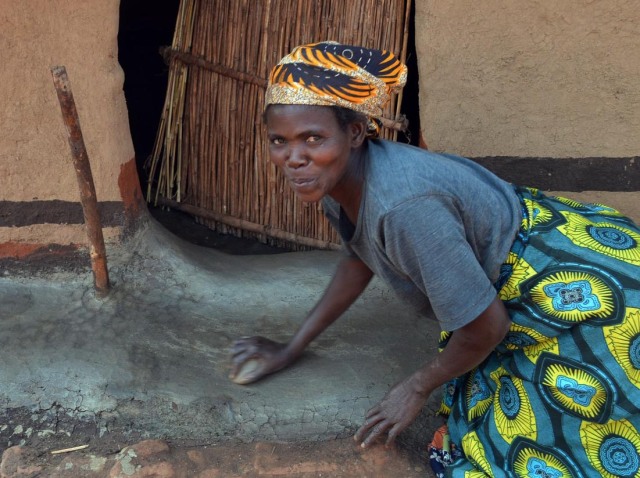A Guest Post by Laura A. Macaluso based on an interview with Jon Twingi Sojkowski of African Vernacular Architecture
This month I had the chance to speak with Jon Twingi Sojkowski, a licensed architect living in the historic area of Beaufort, South Carolina, on the Atlantic coast. Jon took an interest in African vernacular architecture, that is, architecture built out of local materials and using traditional construction techniques, and turned his passion into a project that will serve future generations, whether they are students, tourists or leaders in community development.
The problem with vernacular architecture, as Jon sees it, is that in the 21st century, many people don’t care enough about the vernacular—whether brick, mud or thatch (or any combination thereof)—especially on the continent of Africa. Caring about something comes from awareness of its value but it also creates value, and this is where Jon has chosen to direct his efforts: by designing a series of social media platforms which capture images and information about the vernacular across Africa.
This work is intended to encourage anyone with an Internet connection to see that vernacular architecture is valuable on many levels; it is long-lasting, economically effective, and beautiful. These open access platforms are designed for ease of use, and he hopes that anyone traveling, living, working or studying in Africa will participate.

Jon Twingi Sojkowski with with children in Fango village, Malawi, which he just documented. Photo: Jon Twingi Sojkowski
Jon came to the conclusion that the vernacular needed a champion after spending many years living in a mud hut himself. As a Peace Corps member in Zambia from 1995-1998, Jon had the opportunity to document disappearing vernacular architecture in that country while teaching at the local university. He was teaching during the moment of the “Digital Turn,” that is, when the World Wide Web and all of its software applications were bursting on the scene, creating new opportunities for learning about people and cultures that once were relegated to heavy encyclopedias and scholarly books.
For him, the appreciation of vernacular architecture is an appreciation of people and their culture, a visual and visceral understanding of other people’s lives. Adventures in Preservation, which works with local communities in places such as Albania, Nepal and Mexico, believes in this too. But, Jon noticed that vernacular architecture in Africa was little represented on the web, and he set about changing that through the creation of websites and now, an app built for the iPhone.

The app African Vernacular Architecture (available for free on the App Store) makes documenting easy.
The primary website Jon created, African Vernacular Architecture, brings together his extensive African Vernacular Architecture database (which offers images and information for all 68 African countries) with his earlier designed robust websites on Zambia and Malawi. Also to be found on this primary website are links to all of his social media accounts focusing on the vernacular, including his Tumblr, Twitter, Pinterest, and Flickr feeds, as well as articles posted by newspapers and blogs.
The presentation of vernacular architecture, especially in Africa, can never be a “dry” subject because it is really about the people who live and care for these buildings. Houses and other structures such as churches and schools need a certain amount of yearly care to remain sound, and gatherings of community residents often come together to do this work before the rainy season begins.
But, while Jon and others such as myself, see local identity and community development built into each structure, many people across Africa are abandoning these traditionally built structures for more modern materials such as concrete and metal—creating buildings which Jon argues are neither appropriate for the landscapes they inhabit, nor do they provide the same insulation value that thatch provides.
Of course, against the tide of Hollywood films, where people around the world see a vision of the American Dream as a large home with multiple bathrooms, tracts of green lawn (doused with chemicals to prevent weed growth) and asphalted driveways, it is hard now to convince others to, seemingly, live with less. But this alternative to big and new is not less; it is just a now-radical and different view of the relationship to the places we live, work and play. In the post-2008 recession environment in which we now live, renewed attention to the benefits of the vernacular is a timely conversation to have, whether in the northern or southern hemisphere.
Jon’s project to document all of Africa’s vernacular architecture is prescient and gutsy—since very few people are engaging in this work, examples of this heritage are being lost every day, which, combined with the fact that the continent is enormous, makes the effort that much more bold. But, such are the qualities are needed to make a difference in the 21st century.
I’m hoping that Jon will find a way to continue his work and return to another country in Africa, documenting its vernacular heritage for the world. Maybe he’ll even run a future Adventures in Preservation project!
Laura A. Macaluso is a Ph.D. candidate in the Humanities at Salve Regina University in Newport, RI. She is currently completing a book about the Portrait of Cinque/Sengbe, a painting from 1840 which depicts the leader of the Amistad mutiny, one of the few successful slave revolts in western history (AASLH/Rowman & Littlefield). She was a Fulbright Scholar to Swaziland in 2008-2010 and enjoys learning and writing about cultural heritage from across the globe.


